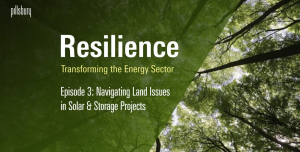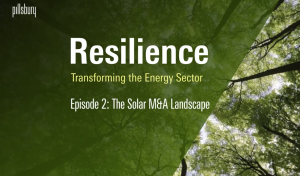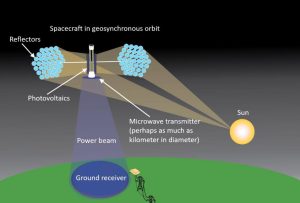 In the newest episode of Resilience, Pillsbury’s Shellka Arora-Cox and guest Adam Hise, Managing Director of Storage Risk Solutions for Ascend Analytics, dive deep into the evolving world of battery storage, market volatility, and how companies are navigating risk in a dynamic energy landscape.
In the newest episode of Resilience, Pillsbury’s Shellka Arora-Cox and guest Adam Hise, Managing Director of Storage Risk Solutions for Ascend Analytics, dive deep into the evolving world of battery storage, market volatility, and how companies are navigating risk in a dynamic energy landscape.
Articles Posted in Energy Transition
Resilience: Transforming the Energy Sector – Navigating Land Issues in Solar and Storage Projects | Episode 3 (11.14.24)
 In the latest episode of the Resilience podcast, colleague Shellka Arora-Cox and Laura Pagliarulo, CEO and founder of SolaREIT, get down to the nitty-gritty in a discussion of the interplay of solar power capacity, generation and land use.
In the latest episode of the Resilience podcast, colleague Shellka Arora-Cox and Laura Pagliarulo, CEO and founder of SolaREIT, get down to the nitty-gritty in a discussion of the interplay of solar power capacity, generation and land use.
Resilience: Transforming the Energy Sector – The Solar M&A Landscape | Episode 2 (10.23.24)
 In the latest episode of the Resilience podcast, colleague and host Shellka Arora-Cox sits down with Kevin Yaich, head of M&A at Qcells USA, for a discussion of the current solar M&A landscape.
In the latest episode of the Resilience podcast, colleague and host Shellka Arora-Cox sits down with Kevin Yaich, head of M&A at Qcells USA, for a discussion of the current solar M&A landscape.
Developer Perspectives on Today’s Energy Storage Markets
In 2023, the world added an impressive 45 gigawatts/97 gigawatt-hours of energy storage capacity, nearly tripling year-on-year growth, with the majority driven by battery storage installations. The global energy storage market is projected to continue its rapid expansion in 2024, adding over 100 gigawatt-hours of capacity, primarily from the United States and China. In the United States, battery storage capacity on the grid has grown tenfold to 16,000 megawatts, with expectations to double again this year, led by significant growth in Texas, California and Arizona.
A distinguished panel of energy storage developers convened at the 2024 Infocast Energy Storage Finance & Investment Summit in San Diego to discuss the current market dynamics and future trajectory of energy storage. The following is an edited transcript of their discussion.
Microwave Transmission of Space-Based Solar Power: The Focus of New Attention
 Scientists have long proposed that solar electricity generation in space could be an integral component of the world’s carbon-free future. In the 1970s, a U.S. Navy experiment showed that it might be possible to capture solar power and wirelessly transmit it from outer space using microwave beams. Progress stalled after that early test—the models used were at such a massive scale that creating a real-world system felt like science fiction. Recently, amid growing concerns about power grid security and intensifying legislation around carbon emissions, renewed attention focused on a smaller, more lithe microwave transmission system. This time around, the military is not the only interested party. Scientists around the world are conducting similar research. As investors and governments stand at the edge of a fresh green power opportunity, we look at microwave power transmission and some of the projects in this emerging field.
Scientists have long proposed that solar electricity generation in space could be an integral component of the world’s carbon-free future. In the 1970s, a U.S. Navy experiment showed that it might be possible to capture solar power and wirelessly transmit it from outer space using microwave beams. Progress stalled after that early test—the models used were at such a massive scale that creating a real-world system felt like science fiction. Recently, amid growing concerns about power grid security and intensifying legislation around carbon emissions, renewed attention focused on a smaller, more lithe microwave transmission system. This time around, the military is not the only interested party. Scientists around the world are conducting similar research. As investors and governments stand at the edge of a fresh green power opportunity, we look at microwave power transmission and some of the projects in this emerging field.
Real Estate & Construction News Roundup (04/26/23) – The Energy Transition and a Bit of Brick-and-Mortar Blues
In today’s roundup, Americans can buy homes with bitcoin, new tech aims to engineer a novel building material, federal investments boost the coastline (and construction sales), and more.
Real Estate & Construction News Roundup (03/08/23) – Updates on U.S. Mortgage Applications, the Inflation Reduction Act, and Multifamily Sector
This week’s roundup explores the cooling housing market and plummeting mortgage applications, potential tax-savings as a result of the 2022 Inflation Reduction Act (IRA), and new developments in the multifamily sector.
Real Estate & Construction News Round-Up (11/09/22) – Fractional NFTs, Infrastructure Lobbying, and Experimental Retail
This week’s round-up dives into NFT fractionalization and its potential benefit to increase accessibility in real estate investing, lobbying efforts surrounding Infrastructure Investment and Jobs Act (IIJA) funding, experimental retail spaces, and more.
Green Hydrogen in the Suez Canal Economic Zone
 As green hydrogen production becomes a global endeavor, many countries are vying to become hubs for the production of clean-burning fuel. Among them, Egypt has signed a number of agreements over the last year with international companies to establish green hydrogen production facilities in its Suez Canal Economic Zone (SCZone), a self-sustaining industrial development corridor established in 2016 that consisting of 461 square kilometers and six maritime ports with the stated goal of “transforming the region from a traditional oil and gas shipping route into the world’s longest ‘green’ canal.”
As green hydrogen production becomes a global endeavor, many countries are vying to become hubs for the production of clean-burning fuel. Among them, Egypt has signed a number of agreements over the last year with international companies to establish green hydrogen production facilities in its Suez Canal Economic Zone (SCZone), a self-sustaining industrial development corridor established in 2016 that consisting of 461 square kilometers and six maritime ports with the stated goal of “transforming the region from a traditional oil and gas shipping route into the world’s longest ‘green’ canal.”
Real Estate & Construction News Round-Up (08/24/22) – Local Law 97, Clean Energy, and IRA Tax Credits
This week’s round-up features the intersection of real estate and energy efficiency, including state efforts surrounding clean energy legislation, Inflation Reduction Act tax credits, hotel & hospitality sectors creating sustainable initiatives to reduce carbon emissions, and more.
Continue Reading ›
 Gravel2Gavel Construction & Real Estate Law Blog
Gravel2Gavel Construction & Real Estate Law Blog


